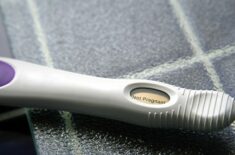Overview
The WHO (World Health Organization) and Lamaze International recommend letting labor begin on its own. They believe that this may be one of the best strategies to reduce the primary cesarean rate. (1)
It may also be safer for pregnant women and their babies for labor to happen naturally. Studies have shown that the baby orchestrates labor when he or she is ready for delivery. (1)
However, certain situations (such as ruptured membranes without labor progression) might require labor induction. (2)
When that happens, your doctor might recommend using Pitocin (a drug form of the hormone oxytocin that promotes uterine contractions) to start labor. (2)
But there are also some ways to induce labor naturally. Are these natural methods safe and effective? Continue reading to find out.
What’s Labor Induction & Why Is It Done?
What Triggers Labor To Start?
During the last weeks of pregnancy, your baby begins to move down into your pelvis and begins to position itself near the birth canal.
The cervix softens and may begin to dilate slowly. The muscles in your uterus become more responsive to oxytocin as they wait for the signal to begin the contractions. (1)
Rising levels of oxytocin promote stronger uterine contractions. The higher the oxytocin levels, the stronger the contractions. (1)
As labor progresses, the amniotic sac ruptures. This sac, which surrounded and protected your baby during pregnancy, is filled with amniotic fluid.
Why Labor Induction Is Done
Most women begin active labor within 24 hours after this membrane ruptures. But this isn’t always the case.
When labor fails to progress despite a ruptured amniotic sac, it could make you prone to infection or certain labor complications. (3)
But a 2014 study showed that it might still be safe to wait for labor to start within 48 hours after the membranes ruptured. That might be safe unless other medical risks were involved (such as high blood pressure). (4)
Still, your health care provider might recommend labor induction or a cesarean delivery during such situations.
At times, labor may progress slower than usual, lasting for over 20 hours. According to the APA (American Pregnancy Association), it usually happens more often to first-time moms than experienced ones. Though it rarely leads to complications, it can be exhausting. (5)
The following are the common reasons for the induction of labor: (6)
- Post-term pregnancy (extends beyond 42 weeks gestation)
- Labor didn’t progress after rupturing of membranes
- Prolonged labor
- Chorioamnionitis (infection in your uterus)
- Oligohydramnios (low levels of amniotic fluid)
- Placental abruption
- Certain medical conditions and risks
Many babies are born post-term without complications. But going beyond 42 weeks can lead to these risks: (7)
- The placenta (the structure that provides nutrients and oxygen to your baby) may begin to deteriorate at this stage.
- The amniotic fluid may become low.
- Your baby might poop in your womb. When that happens, your baby may breathe in or intake meconium (a baby’s first feces) which can cause health problems.
- Normal vaginal birth may be more difficult as the baby gets bigger with each passing day.
- Post-term labor has an increased risk of stillbirth.
10 Natural Ways To Induce Labor
Did you know that as many as 33.7% of pregnant women undergo labor induction each year? This method has actually become a common practice in obstetrics. (6)
What Is The Quickest Way To Go Into Labor?
The following are some of the natural methods for labor induction. Some might work better for others:
Using Herbal Supplements
According to the AAFP (American Academy of Family Physicians), the role of these herbal remedies in labor induction or cervical ripening is still uncertain. But the following are commonly used as alternative methods: (6)
- Black cohosh
- Blue cohosh
- Black haw
Caution: Although blue cohosh may help induce labor, it should only be used with medical supervision. Studies show that it could cause fetal heart failure and multi-organ injuries if used excessively. (8)(9)
Please consult with your obstetrician, midwife, or medical provider before using any herbal supplement to induce labor. This is for the safety of your baby and you.
Using Red Raspberry Leaf Tea
Some research may indicate that women who regularly used red raspberry leaf tea in the latter part of pregnancy were less likely to require a C-section, artificial rupture of the membranes, and forceps or vacuum birth. (10)
More in-depth studies are needed, though.
Using Essential Oils
These are some essential oils that may help induce uterine contractions:
- Evening primrose oil (6)
- Clary sage oil (11)
- Common sage oil (12)
- Sweet almond oil (13)
- Jasmine oil (14)
Breast Stimulation
- Breast and nipple stimulation can promote oxytocin release (which promotes uterine contractions). You can manually stimulate your breasts and nipples or you can also use a breast pump to help. (15)(16)
Sexual Intercourse
The role of sexual intercourse for labor induction remains uncertain. But it might be useful because of the following:
- Semen contains high levels of prostaglandins (promotes cervical ripening). (17)
- Female orgasms are also shown to stimulate uterine contractions. (6)
Sexual intercourse is safe even in the last weeks of pregnancy. Still, doctors don’t recommend doing it after your water has broken as it may increase your risk of infection.
Acupuncture & Acupressure
These traditional Chinese medicine (TCM) techniques have been used for thousands of years. They stimulate points found in channels of qi (energy) flowing along 12 meridians through the body.
Each point connects to a specific organ or function in the body. Some of these points are believed to stimulate uterine contractions and help induce labor naturally. (18)
The points for these traditional techniques are the same.
The difference is that acupuncture uses fine, painless needles to stimulate the points. In contrast, acupressure uses pressure (by using fingers, knuckles, elbows, or tools).
Researchers discovered that though these TCM practices didn’t appear to reduce the need for a C-section, they may help in ripening the cervix and making it ready for labor. These may work by promoting oxytocin release and stimulating the uterus. (19)(20)
Seek the help of an experienced and licensed acupuncturist who specializes in fertility and women’s health before trying any of these techniques.
TENS (Transcutaneous Electrical Nerve Stimulation)
It’s the Western version of the Chinese acupuncture method, without using needles or pressure.
Electrode sticky pads are attached to your lower back and near your bra straps (your physiotherapist can show you how). Once you turn the TENS machine on, it sends a low voltage electrical current to the pads to stimulate uterine contractions and also help relieve pain. (21)(22)
TENS is also believed to promote oxytocin and prostaglandin release. (6)
Walking & Exercise
As many as 43.4% of women who used natural methods for labor induction reported walking or exercising. (23)
It is believed that walking can draw your baby down into your pelvis with some help from gravity. The baby’s pressure on your pelvis might also help ripen your cervix. (24)
It may help relieve stress and prepare your body for labor.
Eating Dates Or Pineapples
A 2011 study found that eating six date fruits a day for four weeks before the estimated due date may reduce the need for labor induction. (25)
Only 28% of the pregnant women who ate dates required Prostin (a prostaglandin) and Pitocin during labor while 47% of the non-date fruit consumers had to use these labor-inducing drugs. (25)
Another study showed that pineapples might also contribute to uterine contractions. (26)
Membrane Stripping: How Can I Get My Cervix To Dilate?
Your obstetrician or midwife inserts a finger through the cervical opening to manually separate the lower part of the membrane (amniotic sac) from your uterine wall.
It’s an uncomfortable procedure that’s only possible if your cervix is ripe and dilated.
It may cause mechanical dilation of the cervix and increase prostaglandin activity for cervical ripening. (27)
OB/GYN Jonathan Emery, MD, of Cleveland Clinic, explains:
“Membrane stripping can increase contractions, but it does not produce significant labor. And a woman should be Group B strep (GBS) negative for this procedure because of the infection risk to the baby.”(28)
Risky Methods You Shouldn’t Try
Drinking Castor Oil
It’s one of the most commonly used alternative methods for cervical ripening from old wives’ tales.
But a 2013 study showed that this isn’t effective in inducing labor. Instead, all the study participants who took castor oil reported feeling nauseous. (29)
Eating Spicy Foods
Although a study showed that this might trigger spontaneous delivery, eating spicy foods can give you heartburn. It may also lead to dehydration, an upset stomach, and other unpleasant side effects. So, it’s best to stay away from this method, unless you like spicy food! (30)
Going On Bumpy Car Rides
Some old wives’ tales suggest going on bumpy car rides. It is believed that the rhythmic pressure on your cervix can stimulate oxytocin release. But there’s no evidence that this actually works. (24)
Common Medical Methods of Labor Induction
There are several methods for labor induction at a medical facility. But your OB/GYN will first check if your cervix is ripe for labor.
Using a system called the Bishop score, your doctor will determine if labor may already be induced. It’s made up of these elements:
- Cervical dilation; score: 0-3
- Effacement (how thin and ripe the cervix is); score: 0-3
- Station (Position of your baby’s head relative to your pelvis); score: 0-3
- Cervical position (relative to your baby’s head and your pelvis); score: 0-2
- Cervical consistency (soft or firm); score: 0-2
You’ll need a Bishop score of at least 8 points before you can be considered for induction.
The following methods may be used to help you get started with your baby’s delivery once your cervix is ready:
Using Prostaglandins & Other Drugs
Prostin (a drug that contains the hormone prostaglandin) helps in cervical ripening (soft and thinned out for delivery). As the cervix ripens, it could signal your body to start the labor process. (6)
Other drugs for labor induction include: (6)
- Cytotec
- Mifeprex
- Relaxin
Using A Foley Bulb Or Catheter
This soft silicone tube/catheter has a balloon near the tip. The tube is inserted into your cervix and the balloon part is slowly inflated by filling up with sterile salt water fluid.
The inflated bulb/balloon puts pressure on your cervix and may help induce labor. (6)
Amniotomy
If your “water” or membranes haven’t broken yet, then your health care provider might perform an amniotomy. (6)
It’s a procedure in obstetrics wherein your obstetrician intentionally ruptures your amniotic sac.
Using Pitocin
This synthetic drug contains the hormone oxytocin to promote uterine contractions. It’s a common method to induce labor when the cervix is already ripe. (6)
These are common methods used at medical facilities, but you might also opt to try natural methods for labor induction. You can do many of these methods at home.
Benefits Of Letting Labor Start Naturally
These are some of the benefits of waiting for your body to start on its own: (31)
- It gives your baby more time to build muscles and develop in your womb.
- It may reduce the risk of infections.
- It may reduce the risk of jaundice (yellowing of your baby’s skin and eyes because its liver might not be mature enough to process and remove bilirubin, a yellow substance produced by the normal breakdown of red blood cells).
- It may help improve breathing and feeding after birth.
- It helps promote better brain development.
Sometimes allowing labor to begin naturally isn’t an option and that’s ok, mama.
Whatever your induction and labor plan, know that you’re doing a great job and many times things happen that we can’t control.
Give yourself grace and trust your body through whatever your birth journey becomes.
Risks & Precautions Of Inducing Labor Naturally
Some pregnant women want to give birth on certain dates or have other reasons for inducing labor.
Never try inducing labor naturally without the consent of your doctor, midwife, or healthcare provider.
Natural labor induction should only be considered if:
- Your pregnancy is already in full-term (39 weeks) or within the safe early term (37 weeks). (32)
- Your baby is head down.
- You and your baby don’t have existing medical complications (especially placenta or pregnancy-related complications).
- You have received approval from your OB/GYN or main healthcare provider.
Don’t induce labor if you have the following:
- Previous C-section or major uterine surgery
- Placenta previa (placenta blocks cervix)
- Baby in breech or sideways position
- Umbilical cord prolapse
- Active genital herpes infection
- If you haven’t gotten cleared from your doctor or midwife.
REFERENCES
(1) https://www.ncbi.nlm.nih.gov/pmc/articles/PMC2730905/
(2) https://www.ncbi.nlm.nih.gov/books/NBK459264/
(3) https://obgyn.onlinelibrary.wiley.com/doi/pdfdirect/10.1034/j.1600-0412.2002.810306.x
(4) https://pubmed.ncbi.nlm.nih.gov/24259235/
(5) https://americanpregnancy.org/healthy-pregnancy/labor-and-birth/prolonged-labor-9140/
(6) https://www.aafp.org/afp/2003/0515/p2123.html
(7) https://www.ncbi.nlm.nih.gov/pmc/articles/PMC3991404/
(8) https://pubmed.ncbi.nlm.nih.gov/11966478/
(9) https://pubmed.ncbi.nlm.nih.gov/9544922/
(10) https://pubmed.ncbi.nlm.nih.gov/10754818/
(11) https://www.ncbi.nlm.nih.gov/pmc/articles/PMC6428160/
(12) https://www.ncbi.nlm.nih.gov/pmc/articles/PMC4280734/
(13) https://academic.oup.com/humrep/article/27/11/3161/811869
(14) https://www.ncbi.nlm.nih.gov/pmc/articles/PMC4280734/
(15) https://pubmed.ncbi.nlm.nih.gov/16034897/
(16) https://pubmed.ncbi.nlm.nih.gov/26444882/
(17) https://pubmed.ncbi.nlm.nih.gov/11406072/
(18) https://www.selkirkmedicalgroup.ca/wp-content/uploads/acupressure.pdf
(19) https://www.ncbi.nlm.nih.gov/pmc/articles/PMC6953318/
(20) https://pubmed.ncbi.nlm.nih.gov/9699760/
(21) https://www.babycentre.co.uk/a542581/using-a-tens-machine-in-labour
(22) https://www.oxfordhealth.nhs.uk/wp-content/uploads/2014/08/OP-100.15-TENS-machine-in-pregnancy.pdf
(23) https://pubmed.ncbi.nlm.nih.gov/21599742/
(24) https://www.ncbi.nlm.nih.gov/pmc/articles/PMC4210668/
(25) https://pubmed.ncbi.nlm.nih.gov/21280989/
(26) https://pubmed.ncbi.nlm.nih.gov/27426506/
(27) https://pubmed.ncbi.nlm.nih.gov/23612695/
(28) https://health.clevelandclinic.org/what-natural-ways-to-induce-labor-actually-work/
(29) https://pubmed.ncbi.nlm.nih.gov/23881775/
(30) https://www.ncbi.nlm.nih.gov/pmc/articles/PMC4106670/
(31) https://www.ncbi.nlm.nih.gov/books/NBK53624/
(32) https://www.marchofdimes.org/pregnancy/what-is-full-term.aspx
(33) https://pubmed.ncbi.nlm.nih.gov/14675973/












